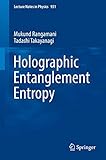Holographic Entanglement Entropy [electronic resource] / by Mukund Rangamani, Tadashi Takayanagi.
Material type: TextSeries: Lecture Notes in Physics ; 931Publisher: Cham : Springer International Publishing : Imprint: Springer, 2017Edition: 1st ed. 2017Description: IX, 246 p. 133 illus., 66 illus. in color. online resourceContent type: text Media type: computer Carrier type: online resourceISBN: 9783319525730Subject(s): Quantum field theory | String theory | Condensed matter | Quantum computers | Spintronics | Mathematical physics | Quantum Field Theories, String Theory | Condensed Matter Physics | Quantum Information Technology, Spintronics | Mathematical PhysicsAdditional physical formats: Printed edition:: No title; Printed edition:: No titleDDC classification: 530.14 LOC classification: QC174.45-174.52Online resources: Click here to access online
TextSeries: Lecture Notes in Physics ; 931Publisher: Cham : Springer International Publishing : Imprint: Springer, 2017Edition: 1st ed. 2017Description: IX, 246 p. 133 illus., 66 illus. in color. online resourceContent type: text Media type: computer Carrier type: online resourceISBN: 9783319525730Subject(s): Quantum field theory | String theory | Condensed matter | Quantum computers | Spintronics | Mathematical physics | Quantum Field Theories, String Theory | Condensed Matter Physics | Quantum Information Technology, Spintronics | Mathematical PhysicsAdditional physical formats: Printed edition:: No title; Printed edition:: No titleDDC classification: 530.14 LOC classification: QC174.45-174.52Online resources: Click here to access online  E-BOOKS
E-BOOKS
| Current library | Home library | Call number | Materials specified | URL | Status | Date due | Barcode |
|---|---|---|---|---|---|---|---|
| IMSc Library | IMSc Library | Link to resource | Available | EBK15688 |
Acknowledgments -- Introduction -- I Quantum Entanglement -- Entanglement in QFT -- Entanglement entropy in CFT2 -- Single interval in CFT2 -- II Holography and entanglement -- Holographic entanglement entropy.-Deriving holographic entanglement proposals -- Properties of holographic entanglement entropy -- III Entanglement and quantum dynamics -- Quantum quenches and entanglement -- Entanglement in excited states -- Holographic many body systems -- Entanglement and renormalization -- IV Quantum Gravity -- Prelude: Entanglement builds Geometry -- Entanglement at large central charge -- Geometry from entanglement -- AdS/CFT and tensor networks.
This book provides a comprehensive overview of developments in the field of holographic entanglement entropy. Within the context of the AdS/CFT correspondence, it is shown how quantum entanglement is computed by the area of certain extremal surfaces. The general lessons one can learn from this connection are drawn out for quantum field theories, many-body physics, and quantum gravity. An overview of the necessary background material is provided together with a flavor of the exciting open questions that are currently being discussed. The book is divided into four main parts. In the first part, the concept of entanglement, and methods for computing it, in quantum field theories is reviewed. In the second part, an overview of the AdS/CFT correspondence is given and the holographic entanglement entropy prescription is explained. In the third part, the time-dependence of entanglement entropy in out-of-equilibrium systems, and applications to many body physics are explored using holographic methods. The last part focuses on the connection between entanglement and geometry. Known constraints on the holographic map, as well as, elaboration of entanglement being a fundamental building block of geometry are explained. The book is a useful resource for researchers and graduate students interested in string theory and holography, condensed matter and quantum information, as it tries to connect these different subjects linked by the common theme of quantum entanglement.


There are no comments on this title.